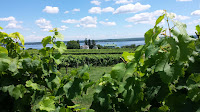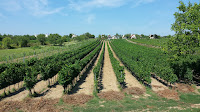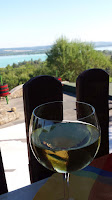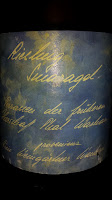
Yes, wine was obviously the focus of the 2015 Wine Bloggers Conference, but the Finger Lakes also provides ample opportunities to sip other locally produced boozy products. It started with beer when I first arrived in Corning. The
Market Street Brewing Co. was only a few blocks from the host hotel and with a few hours to kill before the bus left for the Seneca Lake pre-excursion, I settled in with a sampler. The beers range from Lager to IPA, Wit to Red to Brown, with the simple
Mad Bug Lager dampening the driving nerves and refreshing the palate.

Cider made it's first appearance during the Seneca Lake pre-excursion at our visit to
Ventosa Vineyards where Autumn Stoscheck was pouring the
Eve’s Cidery Autumn’s Gold Traditional Method Sparkling Cider. This cider received many compliments and thanks to
Tom Wark, during the conference I was also able to sample more sparkling cider from Eve's such as the 100% varietal
Northern Spy and orchard designate
Beckhorn Hollow. This last was my favorite, probably from it's pronounced tartness and citrus profile. It's produced from a complex blend of Golden Russet, Wealthy, Wixson, Cox Orange Pippin, Northern Spy, Manchurian Crab, Spigold, and Idared apples. Tom also shared their
Essence Ice Cider, made using cryo-concentration (the freezing of late harvest juice). There's plenty of sugar at 15%RS, but completely balanced with the apple's inherent malic acidity.

After the Ventosa visit, many of us ended the evening in Geneva at
Lake Drum Brewing, a new craft brewery owned by Victor Pultinas and Jenna LaVita (vineyard manager and wine maker at Ventosa). She is one busy young lady. In addition to beer, the brewery also produces cider; but it was two sour beers that attracted my attention: the
Wild Ale and
Brett BBL #1. Victor informed me later that both were made with 50% NY malted barley. The
Wild Ale is the lighter, more floral of the two as it contains some hibiscus in the mash tun, and inoculated with lactobacillus for tartness. The
Brett BBL #1 is much more complex with a complete funky nature.
Victor describes its creation: "The Brett
was made in December as a Pale Ale that went into a Chardonay barrel from
Hosmer Winery. It went through a secondary fermentation in the barrel with both brettanomyces and lactobacillus. It sat in barrel for just about eight months developing a light sour tangy taste stemming from the brett bacteria". This is one serious beer.
Also serious is the
Apple Country Spirits Pear Brandy (rested in oak barrels) that I opened at Lake Drum. New York law allows craft breweries to sell New York craft spirits, but only by the bottle - not by the snifter. As a consequence I probably consumed more than necessary but it was hard to stop enjoying this eau de vie styled brandy with it's smooth creamy pear flavor. No wonder the spirit was awarded a Gold medal at the 2015 San Francisco World Spirits Competition.

Another brewery that showed well at the conference was
The Brewery of Broken Dreams, who poured under the tent at lunch.They are located on Keuka Lake in Hammondsport and offered three solid beers at the conference:
Summer Blues Wheat Ale,
Our Daily Enkel Belgium Styled Ale, and
All-4-One American Pale Ale. Another Keuka Lake brewery,
LyonSmith Brewing Co., supplied a couple growlers for our mystery bus excursion destined for Keuka's Inn. The brewery specializes in British styled ales, with the
1814 Flood Porter the first choice of many. Named after the tragic London flood caused by the rupture of a large fermentation tank of Porter, it's a smooth beer with a hint of hops and plenty of mocha flavors.
Myer Farm Distillers appeared at the conference during a popup tasting. This organic farm to flask distillery located in Ovid grows the grain as well as distills and bottles their distillates directly on their farm. There were a plethora of spirits including the
Cayuga Gold Barrel Aged Gin and various whiskeys. The
Four Grain Whiskey and
Wheat Whiskey were very smooth with vanilla caramel profiles, with the Rye Whiskey being naturally a little spicier and hotter, and the
Bourbon Whiskey showing sweet roasted corn flavors. As for the Cayuga Gold, with the absence of juniper, it comes across more of a whiskey with maple flavors.

Finally, the post-excursion Cayuga Lake offered a couple other opportunities to sample Finger Lakes cider and spirits.
Bellwether Hard Cider provided a few ciders starting with their
King Baldwin, an off-dry cider that comes across very dry with the apple's acidity factored in. It's a blend of Tompkins King and Baldwin, thus the name. Their Northern Spy based
Bellwether Lord Scudmore sparkling cider is also very tasty with tart citrus flavors.

At our dinner at
Knapp Vineyards & Winery we were introduced to that winery's distillates featuring
Limoncello and a
Cucumber Vodka. The vodka was fresh and clean, little burn; whereas the lemon and lime Limoncellos were two distinct beings - both reminiscent of the appropriate fruit - oily and refreshing to the palate.
So, if you find yourself vising Finger Lakes wine country, enjoy the many fine wines produced in the area. But don't ignore the many excellent cider, craft beer and spirits within the region.
theCompass Winery, Brewery, Distillery Locator Mobile App will help you locate them. Cheers and safe travels.














































